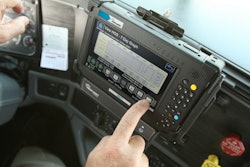
Large fleets that have adopted electronic logging devices in recent years learned that productivity dropped, said Todd Amen, president of owner-operator financial services provider ATBS.
“You lose 10 to 20 percent of your ability to run miles,” said Amen, speaking at Overdrive‘s Partners in Business seminar Friday at the Great American Trucking Show in Dallas.
Most small fleets and independent owner-operators will wait until late 2017 to comply with the mandate, which takes effect in December 2017 unless it’s scuttled in court, Amen said.
“We’re going to have a truck shortage when this ELD rule gets put into effect,” he said. “Essentially it’s like taking 200,000 to 300,000 trucks off the road.”
As a result, he said, “My prediction is rates are going to go up at least 10 percent, but I believe they could go up 15 to 20 percent.”
It’s “counter-intuitive” that miles have gone up for owner operators during the soft freight market of this past year or so, but this has happened during other downturns. “Owner-operators know they need to make miles to earn more money, so they get aggressive,” Amen said. Miles shouldn’t change much until mid-2017, when the ELD transition forces them to drop.
Revenue per mile for owner-operators has come down almost 10 percent, to $1.30, largely because the drop in fuel prices also meant a drop in fuel surcharges, which hurts operators whose efficiency allows them to profit from the surcharge.

Fuel prices should stay relatively low for years, given the number of wells that were drilled in North Dakota and elsewhere that could be producing much more. “I don’t think oil’s going above $60 [a barrel] for the next 10 years,” Amen said.
In the past year, net income has been flat or lower for many ATBS clients, though it averaged a little over $60,000 last year. To earn that income required driving an average 110,000 miles, which shows a big improvement from 13 years ago, when ATBS owner-operators were driving 139,000 miles to earn $47,000.
| Download ATBS’ Friday presentation via this link to follow along with the audio of Amen’s portion of the presentation. The beginning of his presentation corresponds with p. 26 of the pdf. |
In contrast, the U.S. Department of Labor’s cites $40,260 as average income for truck drivers in 2015, said ATBS Vice President Richard DeForest, who also spoke at the presentation. Low compensation is one major reason that turnover is high and many drivers leave the industry, he said.
DeForest cited Schneider National’s Don Schneider, who said recruitment and retention will continue to be problematic until drivers are paid $70,000 — and that was about 13 years ago, meaning the figure would be much higher today due to inflation.
Partners in Business is sponsored by Ryder, Goodyear Smart Fleet and Truckstop.com.













